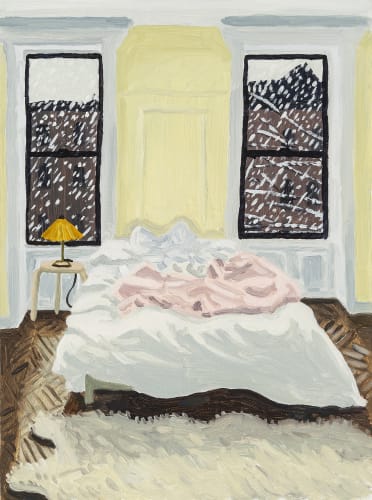Claudia Keep is looking around. She’s constantly observing her surroundings and creating remarkably poignant remembrances of the familiar and oftentimes neglected elements that encompass her daily life. Moths, rural highways, and bedroom still lifes are memorialized through the artist’s singular approach to artmaking. Small in scale, her works on panel and paper are densely packed with textures and details that incite an intense curiosity in the viewer. Where does this road lead? How big is this bug in real life? The clues Keep teases us with leave us wondering what the narrative arc of these overlooked places, objects, and living creatures could be beyond each composition.
The artist, who recently relocated from Brooklyn, NY to Vermont, has had an incredibly prolific and successful career in a relatively short period of time, and continues to push forward and expand the ways in which she lets us see into her extraordinary world. We sat down with the artist to discuss her current exhibition of paintings and watercolors “Aubade” at March Gallery in New York (on view through February 4, 2023), how she works, her move to Vermont, the close relationship she has with her gallerists, and what inspires her tremendous output and intriguing practice.
WHITEWALL: Congratulations on your second solo show at March Gallery. Can you talk about your preparations for this expansive exhibition?
CLAUDIA KEEP: Thank you so much. Well, it’s sort of my first show with March, since my other project with the Gallery was a virtual exhibition. I’ve been thinking about this show for a long time, but I suppose it was in the spring of 2022 that Phillip March Jones, the owner of March, and I came up with a more concrete concept for it. Phillip called me and read me Aubade, the poem by Philip Larkin, and we decided that would be a good organizing focus for the show.
My preparation for the show was mostly painting as much as I could. I painted with Aubade in mind in a loose sort of way. I didn’t try to illustrate the poem but turned my attention more to the themes and imagery already present in my work that shared something in common with the poem.
WW: There are certain elements that recur throughout your paintings, both in this show and in your larger practice: insects, highways, bedrooms, landscapes, cityscapes, animals and views from windows, to name a few. How did some of these subjects first find their ways into your work?
CK: My work is very local to me, in that it is drawn from my daily experiences. My subjects mostly find their way into my work by proximity. I’ve painted cars and roads for a while—I first became really aware of the road while living in Maine. I was driving around a lot, both by myself and with friends. So, most things I saw were through car windows and along the side of the road. I also became fascinated by the color of pavement. In a funny way, the road functions a little like a sky because its color and texture are so mutable. It’s also something that is maybe a little bit ugly and awkward, which is attractive to me, and that allows me a way into landscapes that are otherwise too beautiful.

